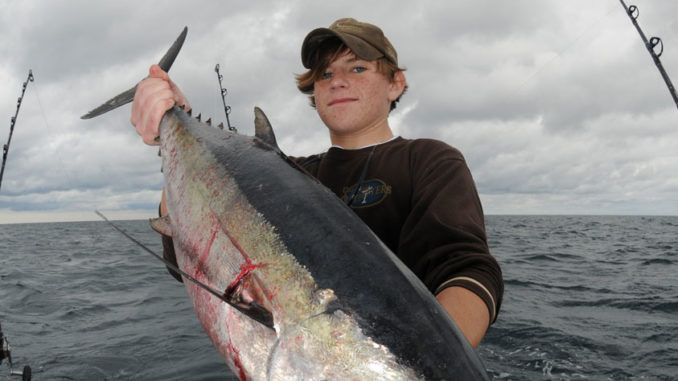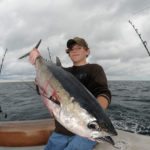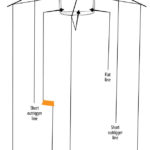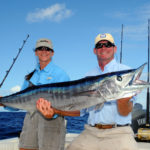
Bluewater action cranks up this month in offshore areas from Cape Fear to Cape Romain. Here’s how to find the wahoo and blackfin tuna you deserve.
Long Bay is a deep, scalloped bay in the coastline that runs from South Carolina’s Cape Romain up the coast to North Carolina’s Cape Fear, more than 100 miles, fed by several larger rivers and home to excellent inshore and nearshore fishing.
The offshore fishing is good, too, but it’s a long run from many of the ports along the bay’s curve to the Gulf Stream. Many fishermen believe the run is well worth it, based on their excellent catches.
Dedicated fishermen ply the edge of the Gulf Stream from inlets like the mouth of the Cape Fear River, Little River, Murrells Inlet and the mouth of Winyah Bay. The numbers are greatly reduced during the winter, but offshore fishermen bloom each spring like flowers when the weather begins to calm and the wind switches from northeast to southwest, shifting the Stream closer to the shore. However, the arrival of increasing numbers of wahoo and blackfin tuna are probably the biggest attraction for fishermen.
Wahoo and blackfins are the primary offshore fish caught in April, but there are some early billfish and dolphin. Wahoo and a few blackfins are caught occasionally off Long Bay all winter, but their numbers begin to increase between mid-March and mid-April. Most of the blackfins will be smaller, but the wahoo will be mixed between small fish and behemoths approaching 100 pounds. Dolphin catches usually increase near the end of April, but there is speculation they will arrive early this year because of the mild winter.
Brent Ballard of Tailwalker Marine in Georgetown, S.C., who has been fishing the waters off Winyah Bay for years, said April is when offshore trolling begins to pick up.
“Our early fishery has become primarily a wahoo fishery, and most fishermen are fast-trolling,” he said. “It’s almost like it has become the new fad. Probably 90 percent of the fishermen want lures they can troll at up to 20 miles an hour. There are also some blackfins around, but most fishermen are after wahoo and consider them a side catch.”
High-speed lures from Blue Water Candy and Fathom are local favorites, trolled behind trolling sinkers weighing up to 64 ounces to get them deeper at the faster speeds. Color preferences, according to Ballard, haven’t changed; fishermen prefer purple, purple/black, black/red, blue/white and pink/blue. Some fishermen also like a little mylar to add flash.
“This type of trolling takes heavier equipment … mostly 80-class rods and reels, but some folks want the heaviest and go to 130-class tackle,” he said. “The rods are mounted on bent butt rods to help eliminate strain. The 30- and 50-class equipment that most folks use for dolphin won’t handle this.
“The spread is smaller too, because most outriggers won’t handle the strain of the heavy sinkers and big lures at the fast speeds. We’ve found some carbon-fiber outriggers from Gemlux that will handle it and let folks troll a few more lines, but they aren’t cheap. Without the outriggers, three or four lines is all you can troll without risking tangles.”
Ballard said most fishermen begin in 120 to 150 feet of water. The large, livebottom areas south and inshore of the Winyah Scarp and southwest of Georgetown Hole are popular areas close to deeper water if anglers don’t find conditions they like.
Ballard said each line has heavy braided wire for a leader to help absorb the shock of the strike and protect from a wahoo’s teeth. He said the lures are fished naked, as ballyhoo and strips won’t stand up to the faster speeds. Trolling sinkers of different weights and different line lengths are used to position the lures at different depths in the water column and different distances behind the boat.
The reel makes a sound many fishermen never hear when a big wahoo hits a lure moving 20 knots in one direction while it is swimming 40 knots in the other. It’s either music to your ears or a banshee’s wail; you get to pick.
Joe Seegers is a licensed captain who earned his offshore chops mating on charter boats out of Hatteras for more than a decade before moving to Wilmington to run his family’s boat, Hooked Up, out of the Cape Fear River at Southport. Fishing for wahoo is one of his passions, and he does it well.
“I’m a little old-school when it comes to wahoo fishing, but there are lots of days it pays off well,” Seegers said. “I will often troll a pair of high-speed lures to see if I can snag a wandering fish while heading offshore, but when I get to where I want to begin fishing, I switch to a much more-conventional trolling spread that features lures sweetened with (ballyhoo) to attract other species. There might even be a naked ballyhoo in the mix, too. There certainly is one rigged to be a pitch bait if an opportunity arises.”
Seegars said he has lures rigged on mono and fluorocarbon blackfins or dolphin, but he trolls 30 feet of No. 10 single-strand wire the majority of the time when wahoo might be around. He hates to lose a wahoo, especially one that bites through the leader, so he goes prepared. He said dolphin, blackfins and even hungry billfish don’t shy away from the wire leaders. He admits the long wire leader is a little more difficult to handle landing a fish, but he believes the lack of bite-offs is well worth that inconvenience.
Seegers fishes primarily dark colors, admitting a preference for purple/black, red/black, and dark blue/black. He joked that purple/black was his favorite color, with black/purple being second. He also likes ballyhoo rigged naked. His one oddity is a single bright lure — blue/white or pink/blue — set in the middle of his spread.
“My spread is seven lines on my boat, and that easily reduces to five on a smaller boat,” he said. “I begin with long- and short-outrigger lines on both sides. As most smaller boats don’t have double-rigged outriggers, this reduces to a single outrigger line on each side. I run a planer line on the port side and a short flat line on the starboard side. The planer line is crucial. Most days it gets about half the wahoo strikes, and when it trips, it brings any following wahoo up to the long-rigger bait.
“My shotgun line is what I do different than most fishermen,” Seegers said. “The captain I spent most of my time with at Hatteras didn’t use a shotgun line, so if I put one out, I had to watch it. Most fishermen run their shotgun line as the longest line on the boat, behind the long-rigger lines, but I put the one bright lure on the shotgun line and bring it up into the middle of the spread. The shotgun bait is positioned between the long-rigger lines and the short-rigger lines on a full spread and would be between the outrigger lines and a flat line on a smaller boat.
“The shotgun line is the lone bright lure, and being in the middle of the spread, anything that wants it has to swim by other baits,” Seegers said. “Sometimes it’s an attractor, and sometimes it gets whacked. I’ve caught some really big wahoo on the shotgun line fished like this.”
Seegars said trolling speed is important, usually 5 to 7 knots, but cautions not to try to set it by GPS speed. GPS speed is speed over ground, but what is important is speed through the water. When heading into a current, the speed over ground will be slower than the speed through the water, and when fishing with the current, the speed over ground will be faster than the speed through the water. Seegers said that what he looks for is a speed that is slow enough the lures aren’t flying out of the water and fast enough to keep the tails of the ballyhoo wiggling. He sets this speed by engine rpm and said it may vary from day to day with changing conditions. And if he is having short strikes, he speeds up about 100 rpm; the quicker pace usually helps improve the hookup ratio.
Dr. Mitch Roffer operates ROFFS (Roffer’s Ocean Fishing Forecasting Service), where he and a team of oceanographers study the oceans currents and their interactions. Roffer said the dynamics of the weather, Gulf Stream flow and bottom strata combine to create areas holding food at the water temperatures fish prefer.
The predominant spring winds help move the Gulf Stream onto the Continental Shelf, where the currents strike the bottom structure and disrupt the flow, creating upwellings and eddies that trap baitfish and attract predators.
“The most predominant positive feature for Georgetown Hole up to the Steeples is a big counter-clockwise eddy on the west Gulf Stream wall,” Roffer said. “This will push Gulf Stream water inshore. Georgetown Hole usually sees Gulf Stream water first as it moves in from the south. However, it may also get Gulf Stream water from a back-loop eddy.
“Most eddies move up the inshore edge of the Stream, but when they reach the Steeples, they sometimes develop or redevelop as elongated pieces of water and may move south,” Roffer said. “A seriously redeveloping elongated eddy might push back down the inshore edge of the stream all the way to Georgetown Hole. In the same type of development, a back-loop eddy could form from interaction farther up the coast, like with the Big Rock off Cape Lookout, and form a back-loop eddy that pushes back to the Steeples and beyond.
Roffer said forming eddies might take a few days to attract fish, and older eddies might hold less bait and fewer fish; this is a reason to check their formation regularly. He said other factors that help attract and hold pelagic fish include temperature, the position of the Gulf Stream, stable Stream and eddy boundaries, currents and chlorophyll. During the spring, the Gulf Stream usually migrates a bit inshore, and this brings all of the factors that attract and hold fish over the favorite offshore structures of Long Bay.
Roffer said it’s important to note that the positions of eddies and edges are always at least shifting a little as the Gulf Stream flows northward. However, with the Stream closer in, there are usually productive fishing conditions somewhere between Georgetown Hole and the Steeples — and sometimes all the way between them. It’s a good time to be fishing off Long Bay and usually results in a lot of catching too.








Be the first to comment